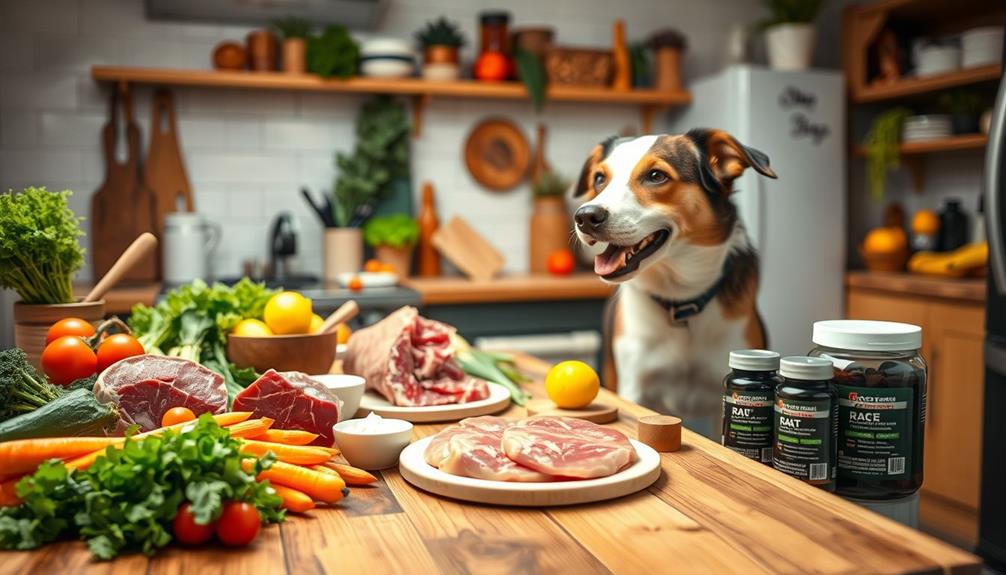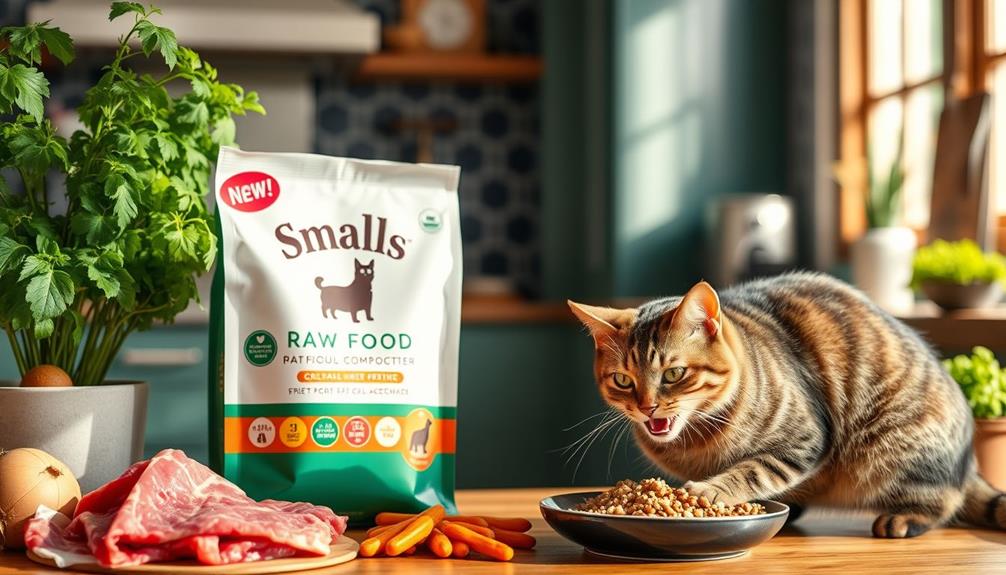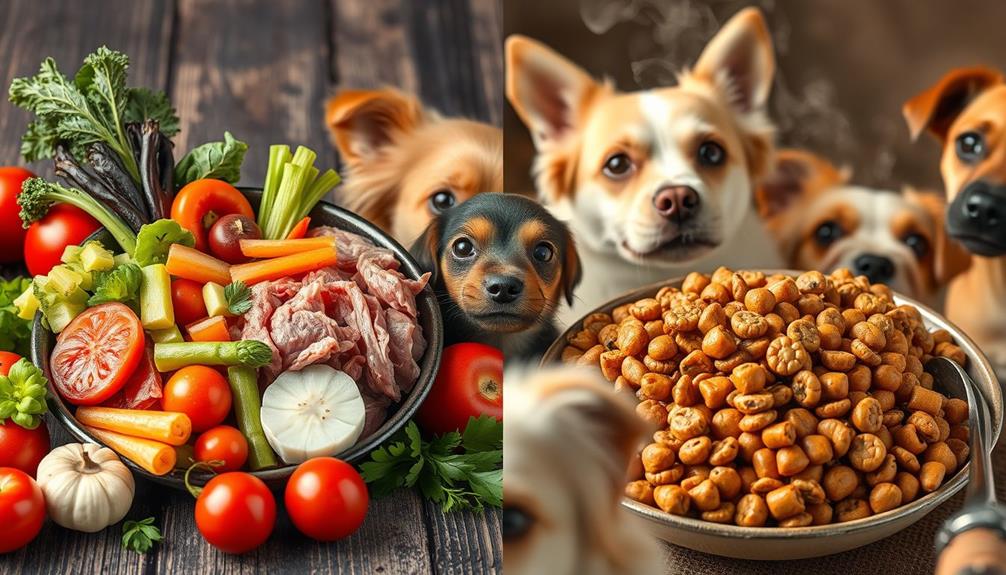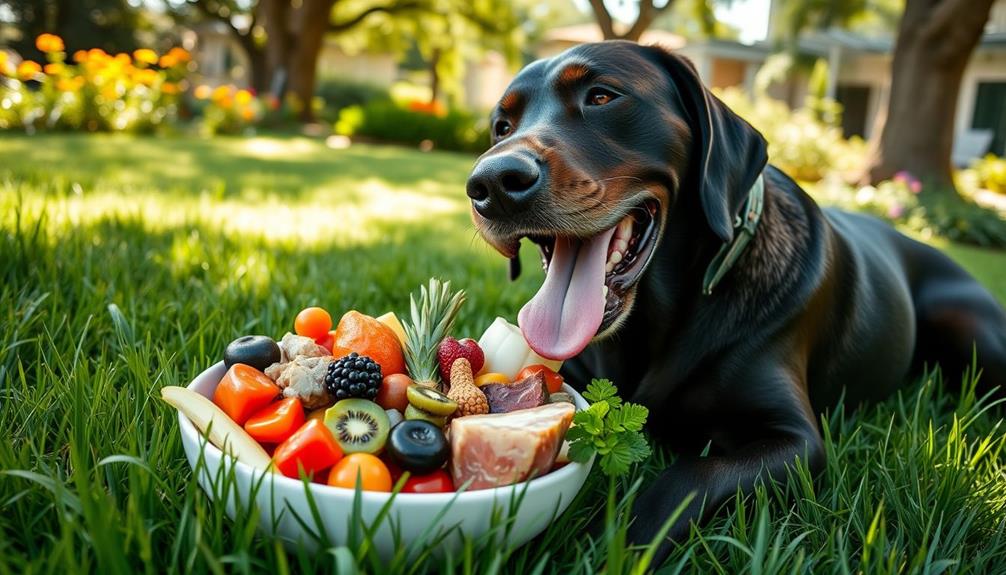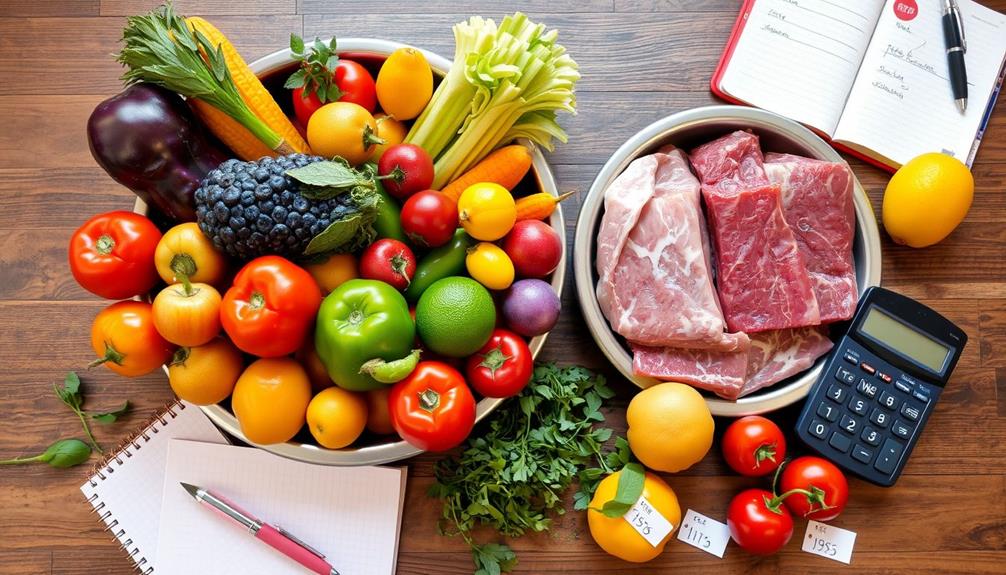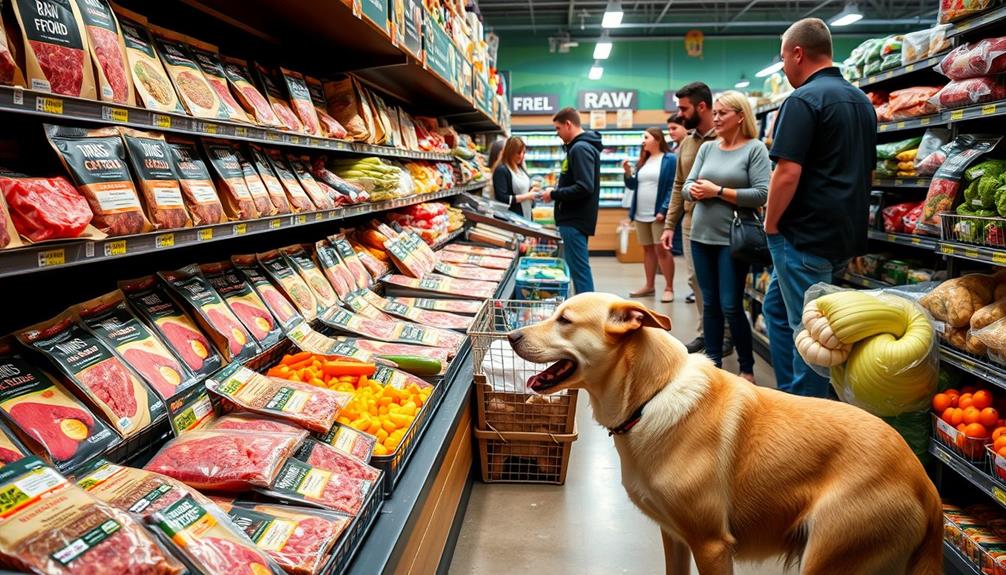Feeding your dog a raw food diet involves several essential steps. Start by gradually shifting to raw food over 7-10 days, mixing 25% raw with their current diet initially. Aim for a balanced mix of 70% muscle meat, 10% bones, 7% veggies, and 5% organs. Portion size should be 2-5% of your dog's ideal body weight, adjusting for activity level. Always practice safe food handling by washing hands, using separate utensils, and thoroughly cleaning bowls after meals. Keep an eye on your dog's weight to guarantee they're thriving, and you'll find even more tips on optimizing their diet.
Key Takeaways
- Transition to a raw food diet gradually over 7-10 days, starting with a mix of 25% raw and 75% current food.
- Feed 2-5% of your dog's ideal body weight daily, adjusting based on activity level and health needs.
- Ensure a balanced diet with 70% muscle meat, 10% raw bone, and a mix of organs and vegetables for nutrition.
- Follow strict safety practices, including sanitizing surfaces and using separate utensils for raw food to avoid contamination.
- Monitor your dog's weight regularly and adjust food portions as needed to maintain a healthy weight.
Understanding Raw Dog Food
Raw dog food is a diet that closely resembles what wild canines eat, consisting of uncooked ingredients like raw meat, organs, and bones. This diet aims to provide a balanced diet that includes approximately 70% muscle meat, 10% raw edible bone, 7% vegetables, 5% liver, and 5% other secreting organs.
By incorporating these components, you're ensuring your dog receives the essential nutrients they need for ideal health. Many pet owners have found that shifting to a raw diet can lead to improvements in their dog's coat quality and energy levels, similar to the benefits seen in proper diet for hamsters.
When you're considering feeding a raw diet, it's vital to remember that dogs possess strong stomach acids and digestive enzymes that help them process raw meat effectively. This makes raw dog food a suitable dietary option for many canines. However, it’s important to do thorough research and consult with a veterinarian before making the switch to a raw diet, as it may not be suitable for all dogs. Some dogs may have underlying health conditions that could be exacerbated by a raw diet, so it’s essential to get professional advice. Additionally, learning about proper raw feeding tips for dogs, such as balancing the diet with fruits, vegetables, and supplements, can help ensure that your dog’s nutritional needs are being met.
However, moving to a raw diet should be done gradually over 7-10 days to minimize digestive upset.
Don't forget the role of vegetables in enhancing nutritional value; properly preparing plant ingredients through pureeing or steaming can greatly improve digestibility and nutrient absorption.
Benefits of Raw Feeding
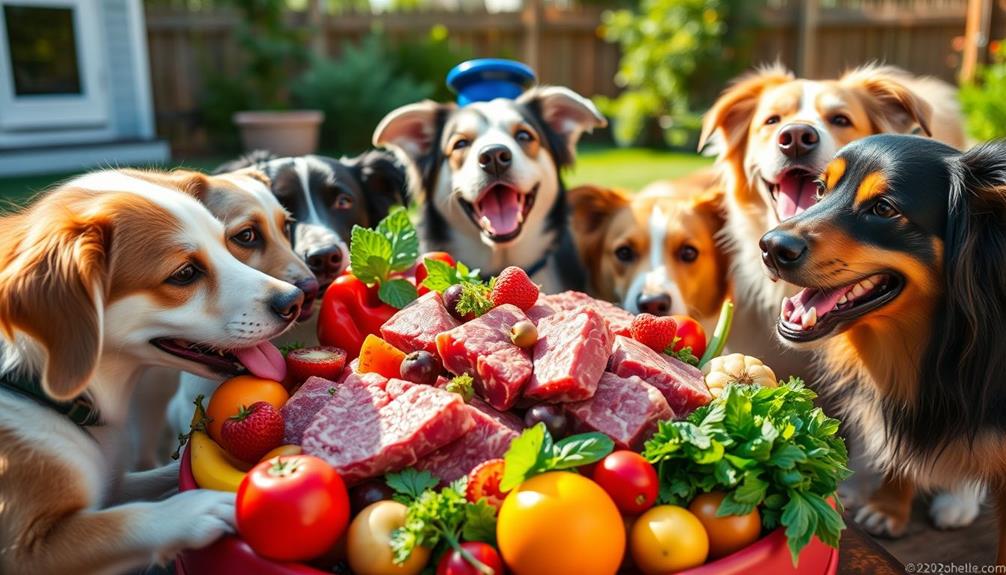
Switching to a raw diet can reveal numerous benefits for your dog's health and well-being. Many dog owners notice significant improvements after making the switch. Here are some key advantages:
- Improved digestion leading to smaller, firmer stools. Natural ingredients in raw diets, like those found in healthy dog snacks, can further enhance digestion and overall wellness.
- Enhanced skin and coat health for a shinier, healthier appearance.
- Increased energy levels from balanced, nutrient-dense nutrition.
Raw diets provide your dog with better nutrient absorption, ensuring they get the most from their food. The natural ingredients help alleviate allergies and sensitivities, making meals more suitable for sensitive pups.
Additionally, the chewing action involved in eating raw proteins and recreational bones promotes dental health by reducing plaque and tartar buildup.
With a raw diet, you're not just feeding your dog; you're investing in their overall health. Expect improvements in energy levels and a noticeable boost in skin and coat health, thanks to the healthy fats and moisture content in raw meats.
Embracing the benefits of raw can lead to a happier, healthier canine companion.
Safety and Handling Practices
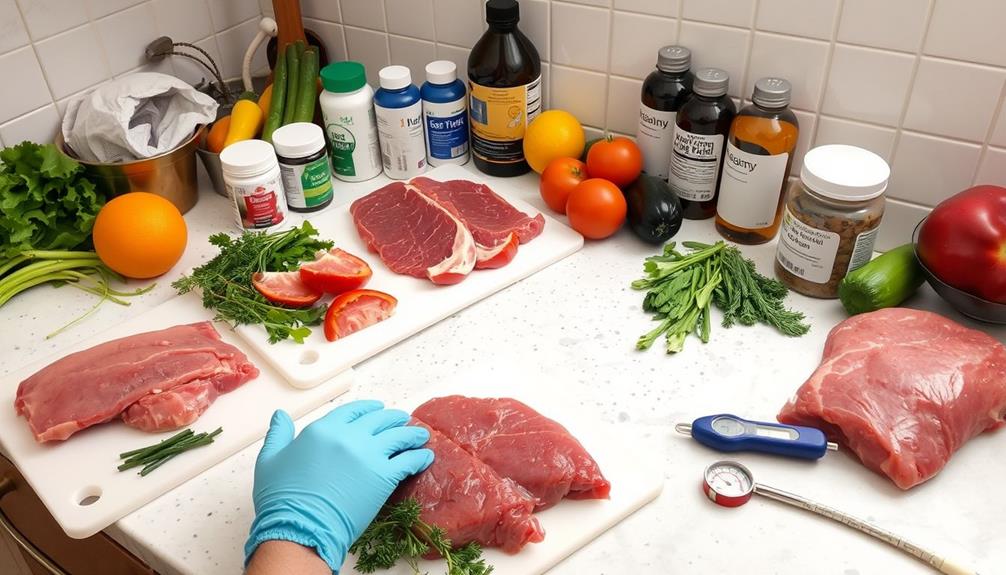
Feeding your dog a raw diet can provide numerous health benefits, but it's important to handle raw food safely to protect both your pet and your household.
Start by following essential safety precautions when handling raw meat. Always wash your hands and sanitize surfaces immediately after preparing raw food to prevent cross-contamination and reduce the risk of foodborne illnesses. Additionally, consider utilizing natural remedies alongside conventional practices to enhance your dog's overall health.
When you store raw dog food, keep it in the freezer to maintain freshness. Remember to thaw it in the refrigerator rather than at room temperature, which minimizes bacterial growth. Use separate utensils and cutting boards exclusively for raw food preparation, making certain no pathogens transfer to your human food items.
After each meal, regularly clean feeding bowls with hot, soapy water to keep a hygienic feeding environment.
It's also essential to monitor your dog while he eats raw bones to prevent choking hazards. Rotate bone types to provide a diverse and safe diet, enhancing your dog's nutrition while keeping mealtime exciting.
Transitioning to a Raw Diet
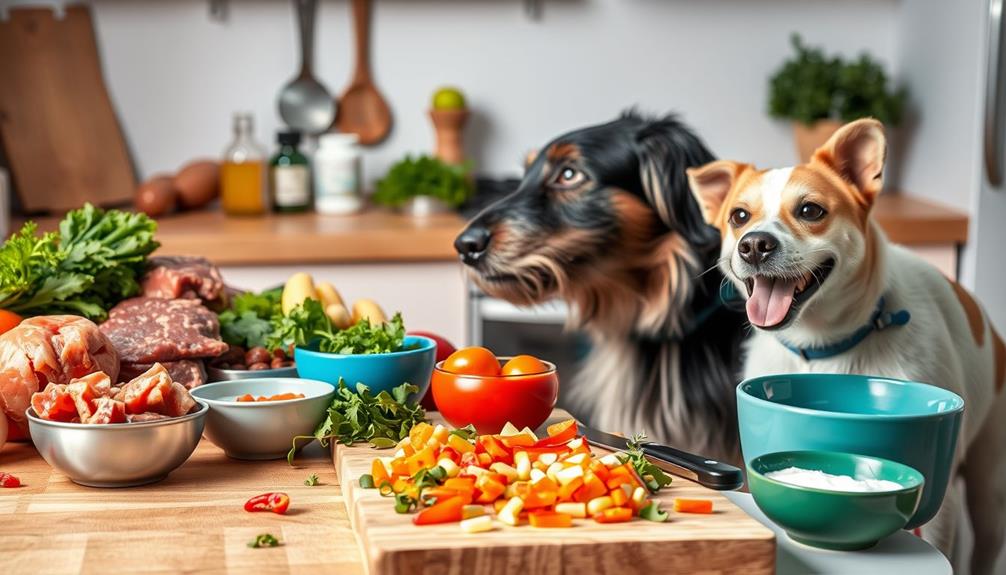
When you're ready to shift your dog to a raw diet, doing so gradually is key to avoiding digestive upset.
It's important to take into account the nutritional balance of the raw diet you choose, just as caregivers must evaluate financial considerations for elderly care to guarantee the best support.
Start the change over 7-10 days by mixing 25% raw food with 75% of their current diet. This gradual change helps ease your dog's digestive adaptation.
Here's a simple outline to follow:
- Days 1-3: Keep the mixture at 25% raw.
- Days 4-6: Move to a 50/50 mix.
- Days 7-10: Shift to 75% raw before fully committing to a raw food diet.
It's essential to monitor your dog's health and digestion closely during this time.
If you notice any signs of digestive upset, like diarrhea or vomiting, adjust the ratio of raw food accordingly.
The recommended daily intake for adult dogs typically ranges from 2-5% of their body weight in raw food, depending on their activity level and individual needs.
Keeping a food diary can help you track your dog's reaction throughout this change.
Don't hesitate to consult with a veterinarian or pet nutritionist for personalized guidance, guaranteeing your dog thrives on their new raw food diet.
Portioning Raw Food Correctly
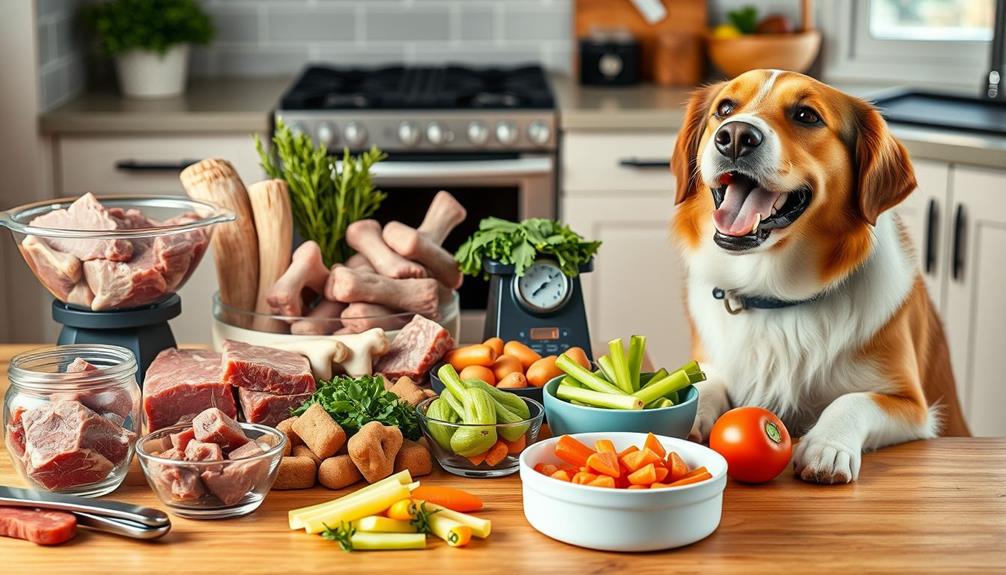
When portioning raw food for your dog, you should aim to feed 2-5% of their ideal body weight each day.
It's important to take into account your dog's specific needs, as factors such as their age, breed, and overall health can greatly influence their dietary requirements.
Regularly adjusting their portions based on their weight and overall health is essential to guarantee the best nutrition, just like monitoring your dietary choices for effective weight loss strategies.
Daily Feeding Amounts
Determining the right daily feeding amounts for your dog is essential for their health and well-being. It's important to base your raw food intake on your dog's body weight, typically ranging from 2-5%. Active dogs may require more to meet their energy needs.
Additionally, guaranteeing your dog receives a variety of nutrients is important for their overall health, as some raw diets may lack essential vitamins and minerals, potentially leading to deficiencies in the long term. Juice diets may lead to nutrient deficiencies if not balanced properly.
Here are some key points to take into account:
- Puppies need more food due to their growth requirements.
- Regular monitoring of your dog's weight helps guarantee you're providing the best nutrition.
- Adjustments should be made based on your dog's life stage and feeding habits.
For instance, a 100-pound dog should receive about 2-3 pounds of raw food daily, while a 25-pound dog would need roughly 0.5-0.75 pounds.
If you're shifting to a raw diet, do it gradually over 7-10 days, starting with 25% raw mixed with 75% of their current food. By Day 10, aim for 100% raw.
Make sure to keep an eye on their weight and health throughout this process. This way, you'll guarantee the right daily intake for your furry friend, supporting their overall well-being and health.
Adjusting Based on Activity
Adjusting your dog's raw food portions based on their activity level is vital for maintaining their health and energy. The general guideline suggests feeding 2-5% of your dog's ideal body weight daily, which aligns with the significance of a well-structured budget for managing finances.
If your pup is active, you might need to increase their raw food intake to meet their energy needs. For instance, a 100-pound dog could require 2 to 5 pounds of food, while a 50-pound dog might need 1 to 2.5 pounds, depending on how much they move.
It's important to regularly monitor your dog's weight and body condition. Adjust portion sizes every few weeks to guarantee they're at a healthy weight and receiving the right nutrition.
Keep in mind that working or sporting breeds often need closer to 5%, while less active dogs may only require 2%.
To better manage this, maintain a daily log of your dog's activity levels and food portions. This will help you fine-tune their dog diet and ensure you're effectively meeting their energy requirements through proper feeding raw.
Cost-Effective Feeding Strategies
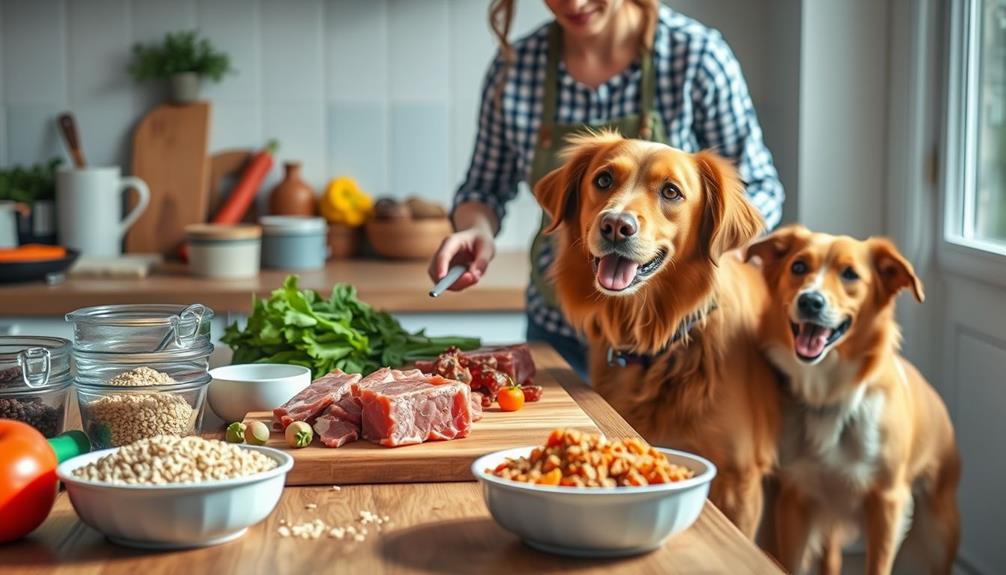
Feeding your dog a raw diet doesn't have to break the bank. With some savvy strategies, you can provide nutritious meals without overspending. Here are a few cost-effective feeding strategies to contemplate:
- Bulk buying: Purchase larger quantities of raw meat and freeze portions to take advantage of sales and discounts. This not only helps you save money but also allows you to explore best economical options for Montessori toys that can be used for your toddler's playtime.
- Budget-friendly cuts: Use less expensive cuts of meat, organs, and meaty bones that are just as nutritious as premium options.
- Meal planning: Organize and rotate different protein sources to guarantee balanced nutrition while minimizing waste.
Engaging with local raw feeding groups or online forums can help you connect with others who share bulk purchases and recommend cost-effective suppliers. You might discover discounts and deals you wouldn't find on your own.
Additionally, contemplate subscribing to raw dog food subscription services that frequently offer lower prices and regular deliveries, saving you time and money on in-store shopping.
Common Myths Debunked
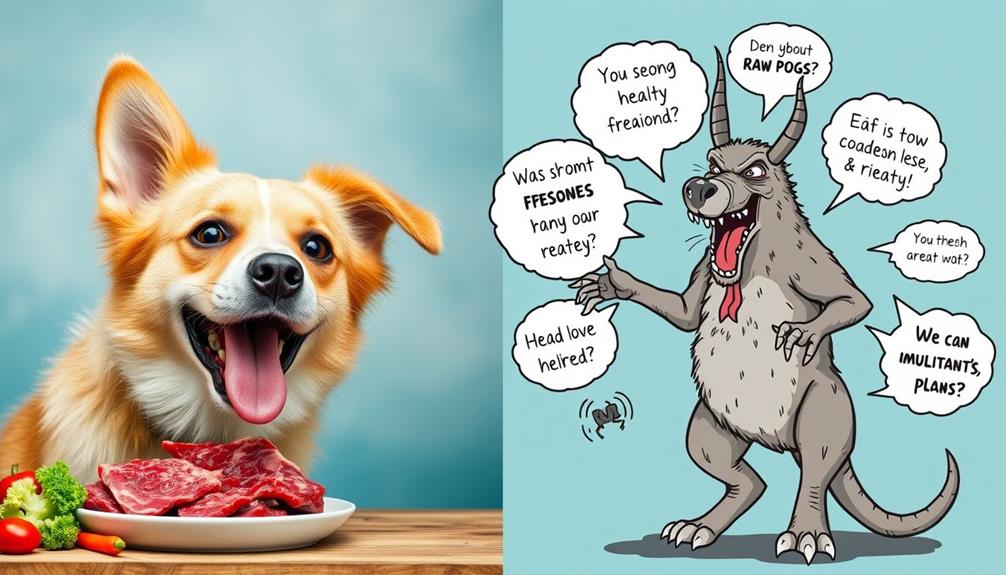
Many dog owners hesitate to switch to a raw food diet due to misconceptions surrounding its safety and complexity. Let's debunk some common myths about feeding raw food and clarify the facts.
| Myth | Reality |
|---|---|
| Raw diets pose high infection risks | With proper handling and storage, like freezing meat, risks are minimized. |
| Dogs can't digest raw food | Dogs have strong stomach acid and enzymes tailored for raw meat digestion. |
| Raw diets lack essential nutrients | A balanced raw diet meets all nutritional needs when formulated correctly. |
| Raw feeding causes aggressive behavior | Behavior is influenced by training and environment, not diet. |
Transitioning to a raw food diet can be straightforward if you plan meals well. You'll find that feeding raw food can actually enhance your dog's immune system and overall health when done right. Remember to focus on providing balanced raw meals that cater to your dog's needs. With the right knowledge and resources, you can overcome these myths and guarantee your dog thrives on a raw diet!
Frequently Asked Questions
What Are the Guidelines for Raw Food Diet for Dogs?
To guarantee your dog thrives on a raw food diet, balance his meals with muscle meat, bone, vegetables, and organs. Gradually shift him to raw, monitor his health, and adjust portions as needed.
How Much Raw Food Should I Feed My Dog Chart?
To determine how much raw food to feed your dog, use their ideal body weight. Generally, provide 2-3% daily, adjusting for activity and age. Monitor their health and adapt portions as needed.
How to Feed Raw Food for Dogs?
You've heard raw diets can be great for dogs, right? Start slow, mixing in raw food gradually. Balance is key—muscle meat, bones, and organs guarantee your pup gets the nutrients they need. Monitor their health closely!
How Do I Work Out How Much Raw Food Should I Feed My Dog?
To figure out how much raw food to feed your dog, calculate 2-5% of their ideal body weight daily. Adjust this amount based on their age, activity level, and overall health needs.
Conclusion
By now, you've learned the ins and outs of raw feeding for your dog. Coincidentally, many pet owners find that their dogs thrive on this natural diet, often showing improved energy and shiny coats. As you commence on this journey, remember to prioritize safety, stay informed, and make the change gradual. With the right approach, you'll not only nourish your furry friend but also strengthen the bond you share, creating a happier, healthier life together.

